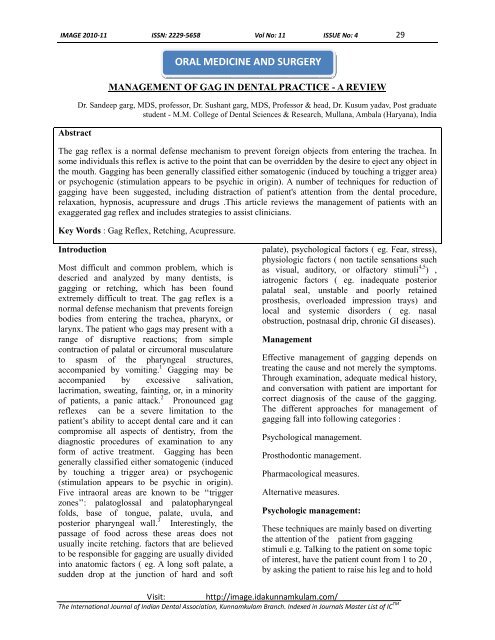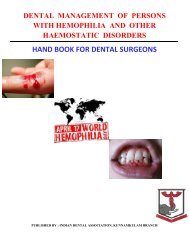'satisfactory smile' with a restorative approach - Indian Dental ...
'satisfactory smile' with a restorative approach - Indian Dental ...
'satisfactory smile' with a restorative approach - Indian Dental ...
Create successful ePaper yourself
Turn your PDF publications into a flip-book with our unique Google optimized e-Paper software.
IMAGE 2010-11 ISSN: 2229-5658 Vol No: 11 ISSUE No: 4 29<br />
Abstract<br />
MANAGEMENT OF GAG IN DENTAL PRACTICE - A REVIEW<br />
Dr. Sandeep garg, MDS, professor, Dr. Sushant garg, MDS, Professor & head, Dr. Kusum yadav, Post graduate<br />
student - M.M. College of <strong>Dental</strong> Sciences & Research, Mullana, Ambala (Haryana), India<br />
The gag reflex is a normal defense mechanism to prevent foreign objects from entering the trachea. In<br />
some individuals this reflex is active to the point that can be overridden by the desire to eject any object in<br />
the mouth. Gagging has been generally classified either somatogenic (induced by touching a trigger area)<br />
or psychogenic (stimulation appears to be psychic in origin). A number of techniques for reduction of<br />
gagging have been suggested, including distraction of patient's attention from the dental procedure,<br />
relaxation, hypnosis, acupressure and drugs .This article reviews the management of patients <strong>with</strong> an<br />
exaggerated gag reflex and includes strategies to assist clinicians.<br />
Key Words : Gag Reflex, Retching, Acupressure.<br />
Introduction<br />
Most difficult and common problem, which is<br />
descried and analyzed by many dentists, is<br />
gagging or retching, which has been found<br />
extremely difficult to treat. The gag reflex is a<br />
normal defense mechanism that prevents foreign<br />
bodies from entering the trachea, pharynx, or<br />
larynx. The patient who gags may present <strong>with</strong> a<br />
range of disruptive reactions; from simple<br />
contraction of palatal or circumoral musculature<br />
to spasm of the pharyngeal structures,<br />
accompanied by vomiting. 1 Gagging may be<br />
accompanied by excessive salivation,<br />
lacrimation, sweating, fainting, or, in a minority<br />
of patients, a panic attack. 2 Pronounced gag<br />
reflexes can be a severe limitation to the<br />
patientís ability to accept dental care and it can<br />
compromise all aspects of dentistry, from the<br />
diagnostic procedures of examination to any<br />
form of active treatment. Gagging has been<br />
generally classified either somatogenic (induced<br />
by touching a trigger area) or psychogenic<br />
(stimulation appears to be psychic in origin).<br />
Five intraoral areas are known to be ëëtrigger<br />
zonesíí: palatoglossal and palatopharyngeal<br />
folds, base of tongue, palate, uvula, and<br />
posterior pharyngeal wall. 3 Interestingly, the<br />
passage of food across these areas does not<br />
usually incite retching. factors that are believed<br />
to be responsible for gagging are usually divided<br />
into anatomic factors ( eg. A long soft palate, a<br />
sudden drop at the junction of hard and soft<br />
ORAL MEDICINE AND SURGERY<br />
palate), psychological factors ( eg. Fear, stress),<br />
physiologic factors ( non tactile sensations such<br />
as visual, auditory, or olfactory stimuli 4,5 ) ,<br />
iatrogenic factors ( eg. inadequate posterior<br />
palatal seal, unstable and poorly retained<br />
prosthesis, overloaded impression trays) and<br />
local and systemic disorders ( eg. nasal<br />
obstruction, postnasal drip, chronic GI diseases).<br />
Management<br />
Effective management of gagging depends on<br />
treating the cause and not merely the symptoms.<br />
Through examination, adequate medical history,<br />
and conversation <strong>with</strong> patient are important for<br />
correct diagnosis of the cause of the gagging.<br />
The different <strong>approach</strong>es for management of<br />
gagging fall into following categories :<br />
Psychological management.<br />
Prosthodontic management.<br />
Pharmacological measures.<br />
Alternative measures.<br />
Psychologic management:<br />
These techniques are mainly based on diverting<br />
the attention of the patient from gagging<br />
stimuli e.g. Talking to the patient on some topic<br />
of interest, have the patient count from 1 to 20 ,<br />
by asking the patient to raise his leg and to hold<br />
Visit: http://image.idakunnamkulam.com/<br />
The International Journal of <strong>Indian</strong> <strong>Dental</strong> Association, Kunnamkulam Branch. Indexed in Journals Master List of IC TM



